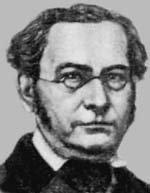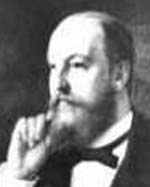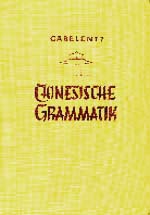Sinological Profiles
Georg von der Gabelentz
16 Mar 1840 (Altenburg) - 11 Dec 1893 (Berlin)Now known in Sinology exclusively as the author of the still-used Chinesische Grammatik, von der Gabelentz in his time was one of the great figures of the second generation of Oriental language pioneers in Europe. Unfortunately for the tradition of classical Chinese studies, it was an abortive generation. General and comparative linguistics fared better.
The larger background was conducive to intellectual success. The Conon von der Gabelentz family was distinguished, politically and otherwise, and it was well-to-do, with a seat at Lemnitz Castle a mile or so southwest of Triptis. Such places have their advantages for persons inclined toward scholarship. For one thing, there is enough room for books and other tools of the trade.
Georg was the second son of the much more renowned Hans Conon von der Gabelentz (1807-1874), who is said to have spoken 24 languages and known 84. Hans's library ran to some 10,000 volumes. A particular focus of interest was Manchu, and he published in 1832 what long remained an important grammar of that language. He was also a cofounder in 1845 of the Deutsche Morgenländische Gesellschaft. His son Georg was five years old at this time. True to the political side of the family heritage, and as the culmination of other services to the state, Hans was Prime Minister of the Duchy of Saxe-Altenburg in 1848-1849, resigning in order to devote himself to his linguistic studies, though he remained President of the Landstag for most of the period until 1870. From this period of this relative scholarly leisure there emerged studies of Syrian, Finnish (which language he was the first in Germany to put on a rational basis), and several American Indian languages. In 1860 he published a monograph on the passive in 209 languages, and in that same year, an article on the grammatical structure of the Melanesian languages. He ventured into classical literature in 1864 with the Manchu translations of the Four Books, Shr Jing, and Shu Jing, plus a Manchu-German lexicon.
All this might seem a daunting parental example, but Georg, seemingly undaunted, taught himself Dutch, Italian, and Chinese during his gymnasium years in Altenburg, 1855-1859. From 1860 to 1864, following closely in his father's footsteps, he studied law, administration, and linguistics at Jena. In 1864 he entered the civil service of Saxony at Dresden. In parallel with this, he continued his study of Chinese, Japanese, and Manchu at Leipzig. He married Alexandra von Rothkirch in 1872. His father Hans died at the family castle of Lemnitz in 1874. Shortly afterwards, son Georg received a PhD from Dresden in 1876, not for linguistic prowess as such, but for a translation of a philosophical text: Jou Dun-yi's Tai-ji Tu Shwo. On 1 July 1878, a Professorship in Far Eastern Languages was established in Leipzig, and Georg was summoned to fill it, resigning at the same time his civil service post. This was the first academic position in the German-speaking world that was dedicated specifically to Chinese and Japanese, rather than to some more general rubric that might allowably include them. It marked in a sense the coming of age of German Sinology.
To those responsibilities, von der Gabelentz was presently to add Manchu, Mongol, Tibetan, and Malay, as well as general and comparative linguistics. His work was admirably empirical in tone; he was no mere theorist. As he put it:
Languages may not be loved Platonically; one must live in and with them before one may venture to form opinions about them.
His masterpiece, at least as seen from the Sinological angle, the Chinese Grammar, appeared not long afterward, in 1881. It is a systematic and careful work, with examples of usage properly credited to the classical texts from which they are drawn. Romanization of Chinese words shows the ru-shvng finals -p, -t, -k (the Chinese transcription of "Leipzig" on the title page profits from that phonetic consciousness), and distinguishes final -m from the other nasals. Had Sinology managed to maintain this phonetically conservative sense of its word material, working Sinologists would now make fools of themselves somewhat less often than they presently do. But the diplomatic prestige of Peking Mandarin was already looming large, and von der Gabelentz's work itself acknowledges and includes the "heutigen Umgangssprache."
His work in general linguistics also prospered. In 1883, building on his father's foundation, he published a study of the relationships among several groups of Pacific languages, a matter of importance to linguistics as well as to the German Colonial Service. In 1884 he became joint editor with F Techmers of the Internationale Zeitschrift für Allgemeine Sprachwissenschaft. His students in Oriental languages at Leipzig included several major figures; among them Wilhelm Grube, who received his PhD in 1881, the same year that Gabelentz's Chinesische Grammatik was first published, J J M de Groot, Arthur von Rosthorn, and the Japanologist Karl Florenz.
All this was most promising, but Sinologically speaking, von der Gabelentz left dead spaces behind him in all phases of his career. The Leipzig phase ended personally with a divorce in 1889. Then came an administrative break: in the winter semester of 1889/1890 he was called to a full professorship at Berlin, the sort of offer one does not refuse. His co-editorship of the Internationale Zeitschrift ceased, and the Oriental Languages chair at Leipzig remained vacant until filled by Conrady in 1891. Gabelentz did little of a Sinological nature at Berlin; his work instead turned increasingly toward general linguistics. In 1891, the year of his remarriage, he published Die Sprachwissenschaft, in which he developed some typological and evolutionary principles going back to Humboldt, and among other things inaugurated the study of what is called grammaticalization. His Handbuch zur Aufnahme fremder Sprachen followed in 1892. Even had be been inclined, few years were left to him in which to form a Sinological tradition at Berlin, and when he died in 1893, at the age of 53, he was not succeeded by anyone of comparable Sinological stature. The emphasis at Berlin had shifted to modern languages and the training of diplomatic personnel. Gabelentz's premodern studies were unofficially carried on by his student Grube, who from a base in the Berlin Ethnological Museum had begun to lecture at the University in 1892. Though making considerable contributions to Sinology while at Berlin (including a briefly praised history of Chinese literature), Grube himself died only a decade later, in 1903. Of von der Gabelenz's other Leipzig students, de Groot was chiefly interested in religion, and von Rosthorn returned to Austria as the chief figure of that country's Sinology, a Sinology which however never developed a critical mass. The promising Leipzig beginning thus in the end ran into Sinological shallows and dead ends, and the more general promise of the Berlin years was fulfilled not at Berlin, but in the work of Meillet and de Saussure, in the next generation of French linguists.
The enduring soundness of von der Gabelentz's Sinological work, as far as it had gone, was attested by Erkes in his 1953 preface to the 1960 reprint of Chinesische Grammatik, written when the modern language and its literature were already swamping Chinese curricula globally:
Es ist zweifellos recht ungewöhnlich, dass ein wissenschaftes Werk nach 70 Jahren eine unveränderte Neuauflage erfährt, und Leser und Benutzer haben ein Recht, zu erfahren, aus welchem Grund und zu welchem Zweck eine solche erfolgt.
Es besteht unter den Sinologen keine Meinungsverschiedenheit darüber, dass eine Grammatik der klassischen Chinesischen Sprache ein vordringliches Bedürfnis für Forschung und Lehre ist, and ebensowenig darübrer, dass die einzige wissenschaftlichen Ansprüchen genügende eben die seit Jahrzehnten vergriffene von Georg von der Gabelentz ist. Der Aussenstehende mag darauf fragen, wieso denn heute, wo die Umgangssprache das Medium der wissenschaftlichen ebenso wie der schöngeistigen Literatur Chinas geworden ist, eine Grammatik der Schriftsprache noch für den ausländischen Studierenden des Chinesischen ein Bedürfnis sei. . .
. . . Ich möchte zum Schlusse meiner Freude darüber Ausdruck geben, dass Leipzig, die Hauptwirkungsstätte des verewigten Verfassers, auch der Ausgangspunkt für das Neuerscheinen seines Hauptwerkes werden durfte, and dass dem jetzigen Inhaber seines Lehrstuhls die Ehre zuteil wurde, dises Neuausgage zu verwirklichen.
Namesakes and descendants of Georg von der Gabelentz are active at the present time in Altenburg. But for all the pardonable pride of Leipzig in its stewardship of his memory, von der Gabelentz's Sinological tradition was of no long duration in his home country, and his heritage is now thinly scattered among a few scholars worldwide, who know him, not in academic succession, but from his publications.
E Bruce Brooks
References
- Georg von der Gabelentz Chinesische Grammatik. Leipzig 1881
- Georg von der Gabelentz. Beiträge zur Kenntnis der Melanesischen, Mikronesischen und Papuanischen Sprachen. Abhandl. d. Kgl. Sächs. Ges. d. Wiss. XIX, Philol. - hist. Kl. VIII (1883) 373-542
- Gustav Schlegel. Hans Georg Conon von der Gabelentz. TP v5 (1894) 75-78
- August Conrady. Georg von der Gabelentz. in: Beilage zur Allgemeinen Zeitung, Nr 361, Beilage Nr 303 (München 30.12.1893) 1-5
- Eduard Erkes. Georg von der Gabelentz und August Conrady, in: Ernst Engelberg (ed), Beiträge zu Universitätsgeschichte 1405-1959, Karl-Marx-Universität Leipzig v1 (1959) 439-463
- Eduard Erkes. Vorwort [1953] to the reprint of Chinesische Grammatik. Niemeyer 1960
- Eberhardt Richter und Manfred Reichardt (ed). Hans Georg Conon von der Gabelentz: Erbe und Verpflichtung. Linguistische Studien ser A Arbeitsberichte 53 (Berlin 1979)
- David Honey. Incense at the Altar. AOS 2001. The sketch of Gabelentz is at 124f
- Christina Leibfried. Sinologie an der Universität Leipzig: Entstehung und Wirken des Ostasiatischen Seminars 1878 bis 1947. Beiträge zur Leipziger Universitäts- und Wissenschaftsgeschichte ser B v1 (2003)
- 125th Anniversary of Gabelentz's Chair at Leipzig (2003)
26 July 2004 / Contact The Project / Exit to Sinology Page




